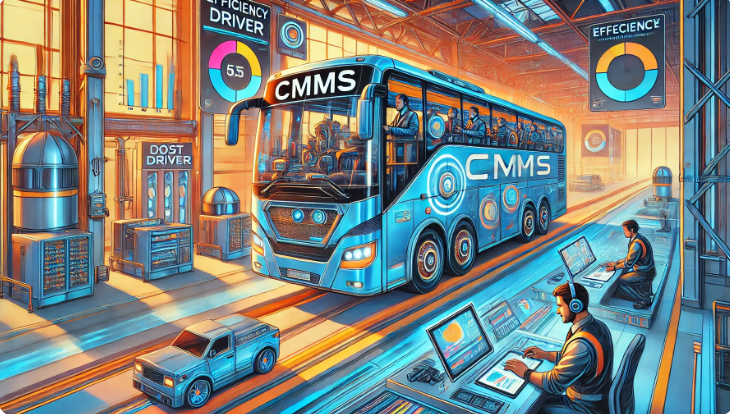Why Your CMMS Needs a Dedicated Driver

Implementing a CMMS is a game-changer for maintenance departments—when it’s done right. However, one of the most common reasons these systems fail to deliver their full potential is that companies expect the users to also act as the system’s drivers. While this approach might seem efficient at first, it’s a recipe for confusion, inefficiency, and ultimately, failure.
The Challenge of Dual Roles
In many organizations, the mechanics, inventory managers, or administrative staff—the people using the system daily—are expected to manage it as well. They enter data like work orders, parts used, or purchase orders and are also tasked with ensuring the system runs smoothly. But here’s the problem: these users are deeply focused on their specific tasks. They don’t have the time, perspective, or technical expertise to see how all the pieces of the system fit together.
This dual role creates several key challenges:
1.Lack of Oversight
Users focus on their specific inputs—mechanics log hours, inventory managers track parts, and so on. But without a dedicated driver, no one is looking at how these inputs interact. For example, work order data might suggest a need to adjust preventive maintenance schedules, but if no one is monitoring the system holistically, those insights are missed.
2.Data Disconnects
When users manage the system, data is often siloed. Mechanics might update work orders, but inventory managers aren’t aware of parts usage trends. Without someone to connect the dots, the system fails to provide the comprehensive insights it’s designed for.
3.Underutilized Features
CMMS systems are robust, offering tools like automated reporting, analytics, and integrations. But users, focused on immediate tasks, rarely have the time or expertise to explore and leverage these features. This means the organization misses out on valuable insights that could improve efficiency and reduce costs.
4.Inconsistent Practices
With no single person guiding the system, practices vary widely between users. One mechanic might enter detailed notes on work orders, while another only logs the bare minimum. These inconsistencies make it difficult to generate reliable reports or gain actionable insights.
5.Inefficiency and Burnout
Expecting users to also drive the system adds to their workload, leading to inefficiencies and frustration. When data entry, reporting, and troubleshooting fall on the same people responsible for hands-on tasks, the system becomes a burden rather than a tool for success.
6.Lack of Technical Expertise
A CMMS system is more than just a standalone tool—it’s part of a larger ecosystem of software used across the organization. To fully unlock its potential, it needs to integrate seamlessly with other systems, such as accounting, payroll, and procurement platforms. This requires technical expertise in areas like API integrations, data mapping, and understanding how different systems interact.
Mechanics, buyers, and supervisors excel in their respective roles, but expecting them to handle complex technical tasks like integrating the CMMS with other software is unrealistic. Without a driver who has this technical knowledge, companies miss out on the efficiencies and insights that come from a fully connected system. The result? Lost opportunities to automate processes, reduce duplication, and create a truly unified workflow.
Why Every System Needs a Driver
Imagine your CMMS as a bus. Your users—mechanics, inventory managers, and supervisors—are the passengers. Each passenger has a specific role: one is responsible for keeping track of parts, another logs maintenance hours, and another oversees work orders. But the bus won’t move forward without a driver.
If you ask the passengers to take turns driving, chaos ensues. They may know the basics of steering, but they don’t have the full knowledge of the route, the mechanics of the bus, or how to get everyone to the destination efficiently. Worse yet, without a dedicated driver, the bus is likely to stay idle or veer off course entirely.
The same is true for your CMMS. Users are crucial for inputting data, but they can’t also be the ones managing the system. A driver—someone who understands the system inside and out, connects the data points, and ensures everything is functioning smoothly—is essential. This person ensures the system stays on track and that every piece of data is working together to create actionable insights.
How TENMIL Becomes the Driver for Your CMMS
At TENMIL, we provide the expertise needed to ensure your CMMS functions as a true system, not just an electronic filing cabinet. Acting as the driver for your system, we:
Understand the Entire System: We have a full view of how the data points connect—how work orders impact inventory, how maintenance logs feed into cost analysis, and how reports drive decision-making.
Bring Technical Expertise: From API integrations with accounting and payroll software to setting up custom workflows, we handle the technical challenges that users shouldn’t have to worry about.
Ensure Consistency and Efficiency: We implement best practices across the system, ensuring data is entered consistently, reports are accurate, and the system runs at its full potential.
Focus on Optimization: As the driver, we don’t just keep the system running—we ensure it’s evolving. We analyze trends, recommend improvements, and help you get the most value from your CMMS.
By letting us take the driver’s seat, your team can focus on what they do best: keeping your operations running smoothly. We’ll ensure your CMMS is more than just a tool—it’s a system that drives success.
A CMMS without a dedicated driver is like a bus without someone behind the wheel—it simply won’t get where it needs to go. Your users are the passengers, critical to the journey but not responsible for driving the system. That’s where we come in.
With our expertise, your CMMS will be a powerful tool for efficiency, insight, and growth. We ensure it’s fully integrated, optimized, and aligned with your organization’s goals. Let us take the wheel, so your system works for you—not the other way around.